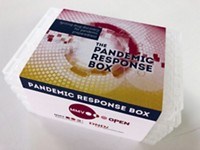Advertisement
Grab your lab coat. Let's get started
Welcome!
Welcome!
Create an account below to get 6 C&EN articles per month, receive newsletters and more - all free.
It seems this is your first time logging in online. Please enter the following information to continue.
As an ACS member you automatically get access to this site. All we need is few more details to create your reading experience.
Not you? Sign in with a different account.
Not you? Sign in with a different account.
ERROR 1
ERROR 1
ERROR 2
ERROR 2
ERROR 2
ERROR 2
ERROR 2
Password and Confirm password must match.
If you have an ACS member number, please enter it here so we can link this account to your membership. (optional)
ERROR 2
ACS values your privacy. By submitting your information, you are gaining access to C&EN and subscribing to our weekly newsletter. We use the information you provide to make your reading experience better, and we will never sell your data to third party members.
Biological Chemistry
Reviving The Malaria Fight
Open Innovation: Companies, consortium publicly disclose scores of potential antimalarial leads
by Carmen Drahl
May 24, 2010
| A version of this story appeared in
Volume 88, Issue 21
Three independent teams have revealed a host of chemical compounds that could inspire new classes of malaria-fighting drugs. Many of the molecules were previously proprietary and have now been deposited into publicly available databases to revitalize malaria drug discovery.

Malaria claims almost 1 million lives each year, and the toll may climb higher if resistance to the most effective antimalarial drugs, the artemisinins, builds up. But with no new classes of drugs since 1996, the malaria pipeline is thin, and public-private partnerships with a mission to fill it have emerged.
With funding in part from one such entity, the Medicines for Malaria Venture (MMV), the groups screened millions of compounds and found thousands that block growth of the malaria parasite, Plasmodium falciparum. Some hits have chemical scaffolds similar to those of established drugs, but many others were not previously known antimalarials.
All three teams’ data are available online at several sites, including that of the European Bioinformatics Institute (www.ebi.ac.uk/chemblntd/download). Making screening data public is crucial for fighting diseases with relatively limited resources, says R. Kiplin Guy of St. Jude Children’s Research Hospital, who led one of the teams. “If you hide data, it slows everybody down,” he says.
Guy led a research consortium that identified nearly 600 hits, one of which, SJ000025081, is effective at treating a mouse with malaria (Nature 2010, 465, 311). Although the team worked to ensure that their hits had druglike properties, follow-up studies are needed before they can be thought of as more than starting points, Guy cautions.
Meanwhile, a GlaxoSmithKline team in Spain led by Jose F. Garcia-Bustos disclosed more than 13,500 hits, as previously pledged (C&EN, Jan. 25, page 19). Of those hits, 8,000 work against a multi-drug-resistant strain of malaria (Nature 2010, 465, 305). A subset of the hits inhibits kinase enzymes, the team’s internal historical data suggest. “Kinases are an emerging field in malaria but an established field in cancer,” and releasing the data could spark collaborations between the kinase and malaria fields, Garcia-Bustos says.
Some data from an earlier screen conducted at the Genomics Institute of the Novartis Research Foundation (Proc. Natl. Acad. Sci. USA 2008, 105, 9059) have also been made public, MMV announced on May 20.
The work “is evidence that the open-source drug discovery movement in pharma is viable and delivering,” says Bernard Munos, an adviser in corporate strategy at Eli Lilly & Co. who has expertise in open innovation.
“One can only hope that the funding agencies will now get behind the most promising leads,” adds Manuel Llinás, who studies the molecular mechanisms of malaria at Princeton University.




Join the conversation
Contact the reporter
Submit a Letter to the Editor for publication
Engage with us on Twitter